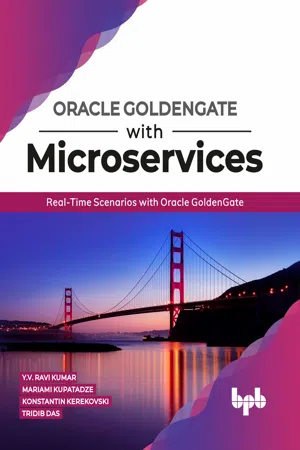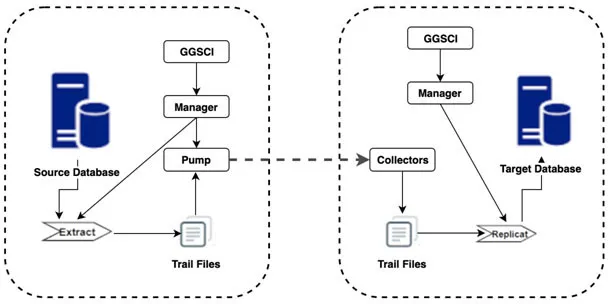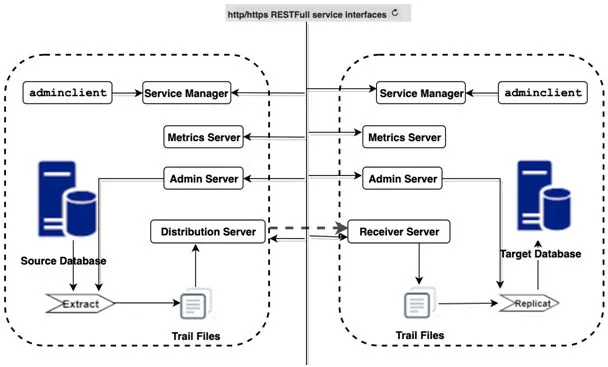
eBook - ePub
Oracle GoldenGate With Microservices
Real-Time Scenarios with Oracle GoldenGate
- English
- ePUB (mobile friendly)
- Available on iOS & Android
eBook - ePub
Oracle GoldenGate With Microservices
Real-Time Scenarios with Oracle GoldenGate
About this book
A step-by-step guide to practising Oracle GoldenGate High Availability (HA) options, Microservices, and Real-Time downstream techniques Key Features
- Understand how and when they're used classic Vs. Microservices
- Learn how to use real-time downstream methods based on the environment
- Learn how to solve Oracle GoldenGate (OGG) Conflict Detection and Resolution (CDR) in bi-directional, active replication
- Learn how to implement high availability for mission-critical systems using Oracle GoldenGate – XAG components
- Learn how to set up bi-directional replication between pluggable databases (PDBs) in a multi-tenant environment
- Learn how to use differently typed of replicates in pluggable databases (PDBs) in a multi-tenant environment
-
Description
The book starts with a brief introduction about Oracle GoldenGate with Microservices and how to configure high availability using various methods. Oracle GoldenGate Microservices Architecture (MA) is a similar architecture based on REST APIs which enable us to configure, monitor, and manage Oracle GoldenGate services using a web-based user interface. Each module supports a specific business goal and uses a simple, lightweight, and well-defined interface to communicate with other sets of services. What will you learn
By the end of the book, you will come across a few case studies about how to use Microservices, Kubernetes, REST APIs in Oracle GoldenGate, and How to monitor Oracle GoldenGate processes in real-time environments. This book also helps how to use various file systems like ACFS, DBFS, and NFS in high availability for Oracle GoldenGate. Who this book is for
This book is intended for anyone looking for how to set up and configure Uni-directional, Bi-directional replication in mission-critical environments either using classic Oracle GoldenGate OR Oracle GoldenGate with Microservices. This book also helps various methods to implement real-time downstream techniques. Table of Contents
1. Introduction to Oracle GoldenGate HA - XAG Components
2. Extract and Replicat in Multitenant Environment
3. Consolidated and Cascaded Oracle GoldenGate
4. Introduction to Oracle GoldenGate Methodologies
5. Introduction to Oracle GoldenGate Utilities
6. Bi-Directional Replication with Conflict Detection and Resolution (CDR)
7. Bi-directional Replication with Pluggable Databases (PDBs) in Multitenant Environment
8. Real-Time Downstream Database with Multiple Scenarios
9. Oracle GoldenGate Microservices Architecture overview
10. Managing Oracle GoldenGate and Kubernetes
11. Automation Recipes Via Rest APIs
12. Oracle GoldenGate Tuning and Troubleshooting About the Author
Yenugula Venkata Ravi Kumar (YVR) is an Oracle ACE Director and Oracle Certified Master (OCM) with 22+ years of experience in the banking, financial services, and insurance (BFSI) verticals. Mariami Kupatadze is an Oracle Certified Master since 2016. She is the first OCM in her country, Georgia. Mari is a member of the ACE program. She has published several articles in OraWorld e-magazine and Oracle Technology Network. Mari has been a speaker in APAC Oracle Users Groups Community (APACOUC) and Luxembourg Oracle Users Group (LUXOUG). Konstantin Kerekovski is an Oracle professional with more than seven years of experience in the financial services industry. He is a member of the Independent Oracle User Group, Suncoast Oracle User Group, and New York Oracle User Group. Tridib Das is a Senior Database Administrator with more than 9 years' experience on Oracle and MySQL.
Frequently asked questions
Yes, you can cancel anytime from the Subscription tab in your account settings on the Perlego website. Your subscription will stay active until the end of your current billing period. Learn how to cancel your subscription.
No, books cannot be downloaded as external files, such as PDFs, for use outside of Perlego. However, you can download books within the Perlego app for offline reading on mobile or tablet. Learn more here.
Perlego offers two plans: Essential and Complete
- Essential is ideal for learners and professionals who enjoy exploring a wide range of subjects. Access the Essential Library with 800,000+ trusted titles and best-sellers across business, personal growth, and the humanities. Includes unlimited reading time and Standard Read Aloud voice.
- Complete: Perfect for advanced learners and researchers needing full, unrestricted access. Unlock 1.4M+ books across hundreds of subjects, including academic and specialized titles. The Complete Plan also includes advanced features like Premium Read Aloud and Research Assistant.
We are an online textbook subscription service, where you can get access to an entire online library for less than the price of a single book per month. With over 1 million books across 1000+ topics, we’ve got you covered! Learn more here.
Look out for the read-aloud symbol on your next book to see if you can listen to it. The read-aloud tool reads text aloud for you, highlighting the text as it is being read. You can pause it, speed it up and slow it down. Learn more here.
Yes! You can use the Perlego app on both iOS or Android devices to read anytime, anywhere — even offline. Perfect for commutes or when you’re on the go.
Please note we cannot support devices running on iOS 13 and Android 7 or earlier. Learn more about using the app.
Please note we cannot support devices running on iOS 13 and Android 7 or earlier. Learn more about using the app.
Yes, you can access Oracle GoldenGate With Microservices by Yenugula Venkata Ravi Kumar,,Y. V. Ravi Kumar,Mariami Kupatadze,Konstantin Kerekovski,Tridib Das in PDF and/or ePUB format, as well as other popular books in Computer Science & Web Services & APIs. We have over one million books available in our catalogue for you to explore.
Information
CHAPTER 1
Introduction to Oracle GoldenGate HA-XAG Components
Introduction
Oracle GoldenGate (OGG) provides data capture and real-time replication mechanisms for heterogeneous databases. The OGG architecture can be implemented for almost all types of replication scenarios. Oracle Grid Infrastructure Bundled Agents (XAG), which is now a part of the Oracle Grid Infrastructure, provides HA and management framework through the AGCTL command line interface.
OGG can be used for a single instance as well as cluster databases. In the cluster environment, GoldenGate can tolerate server failures by moving process to another surviving server. The Real Application Clusters (RAC) database replicated by OGG is considered as a complete high availability (HA) architecture.
Oracle introduced Microservices Architecture from OGG 12.3. The older version is now called Classic Architecture. Oracle Microservices architecture provides access through a secure web interface that simplifies the administration, command line interface, and APIs.
The following illustrates the components of each architecture. The below diagram is a view of an OGG Classic architecture:

Figure 1.1: Oracle GoldenGate Classic Architecture components
The primary access into the OGG classic architecture is via GoldenGate Service Command Interface (GGSCI). From GGSCI, you can control GG processes, such as Manager, Extract (capture), data Pump, and Replicat (apply).
A view of an OGG Microservices Architecture is shown as follows:

Figure 1.2: Oracle GoldenGate MA Architecture components
As you will notice on the diagram, Extract (capture), trail files, and Replicat (apply) are still there. But the following components are modified and added into the MA architecture:
- Service manager: A service manager (SM) is a main interface into the OGG. The SM HTML user interface enables you to see the status of the administration server, the distribution server, the performance metrics server, and the receiver server. From the console, you can start, stop, and query other services and deployments. It acts as the watchdog process for the environment. A service manager is responsible to restart other services that go down.
- Administration server: An administration server is a central management entity for GoldenGate. From a web-based interface, you can create and manage Extract and Replicat processes.
- Distribution server: This server distributes trail files to one or more destination database servers.
- Receiver server: A receiver server coordinates and handles all received trail files.
- Performance metrics server: A performance metrics server collects instance deployment performance results. All performance related metrics are sent to this service from OGG processes.
Additional components in OGG Microservices Architecture are as follows:
- Admin client: Instead of using the GUI interface, you can use the admin client to perform the same tasks. The
adminclientusage example is shown as follows:$ export OGG_HOME=/GG_HOME/ma$ export JAVA_HOME=$OGG_HOME/jdk/jre$ cd $OGG_HOME/bin$ ./adminclientOracle GoldenGate Administration Client for OracleVersion 19.1.0.0.2 OGGCORE_19.1.0.0.0_PLATFORMS_190823.0013Copyright (C) 1995, 2019, Oracle and/or its affiliates. All rights reserved.Linux, x64, 64bit (optimized) on Aug 23 2019 07:49:43Operating system character set identified as UTF-8.OGG (not connected) 5> connect http://localhost:9001 as oggadmin password oggadminUsing default deployment ‘MyDeployment’OGG (https://localhost:9001 MyDeployment) 6> helpAdmin Client Command Summary:! - Executes the previous command without modifications.ADD CHECKPOINTTABLE - Creates a checkpoint table in a database.ADD CREDENTIALS - Create user credentials for use by the Administration Client.ADD CREDENTIALSTORE - (Deprecated) Creates a credentials store (wallet) that stores encrypted database user credentials.ADD DISTPATH - Creates a distribution path.… - Extract process: The capture mechanism of Oracle Golden Gate is called EXTRACT, which runs on a source database. Extract is responsible for capturing committed DML and DDL operations that are performed on objects in the Extract configuration and persisting them to trail files. Multiple Extract processes can operate on different objects at the same time.
- Replicat process: The Replicat process runs on the target system, which reads the trail files and applies them to the target database.
- Trails: A trail is the series of files on the disk where GoldenGate stores the captured data. By default, trails are stored in the
dirdatsubdirectory of the OGG directory and are aged automatically to allow processing to continue without interruption. - Checkpoints: Oracle GoldenGate processes record their read and write positions along the data flow checkpoint files cluster-wide is essentia...
Table of contents
- Cover Page
- Title Page
- Copyright Page
- Dedication
- About the Authors
- About the Reviewer
- Acknowledgements
- Preface
- Errata
- Table of Contents
- 1. Introduction to Oracle GoldenGate HA-XAG Components
- 2. Extract and Replicat in Multitenant Environment
- 3. Consolidated and Cascaded Oracle GoldenGate
- 4. Introduction to Oracle GoldenGate Methodologies
- 5. Introduction to Oracle GoldenGate Utilities
- 6. Bi-Directional Replication with Conflict Detection and Resolution (CDR)
- 7. Bi-directional Replication with Pluggable Database (PDBs) in a Multitenant Environment
- 8. Real-Time Downstream Database with Multiple Scenarios
- 9. Oracle GoldenGate Microservices Architecture Overview
- 10. Managing Oracle GoldenGate and Kubernetes
- 11. Automation Recipes via Rest APIs
- 12. Oracle GoldenGate Tuning and Troubleshooting